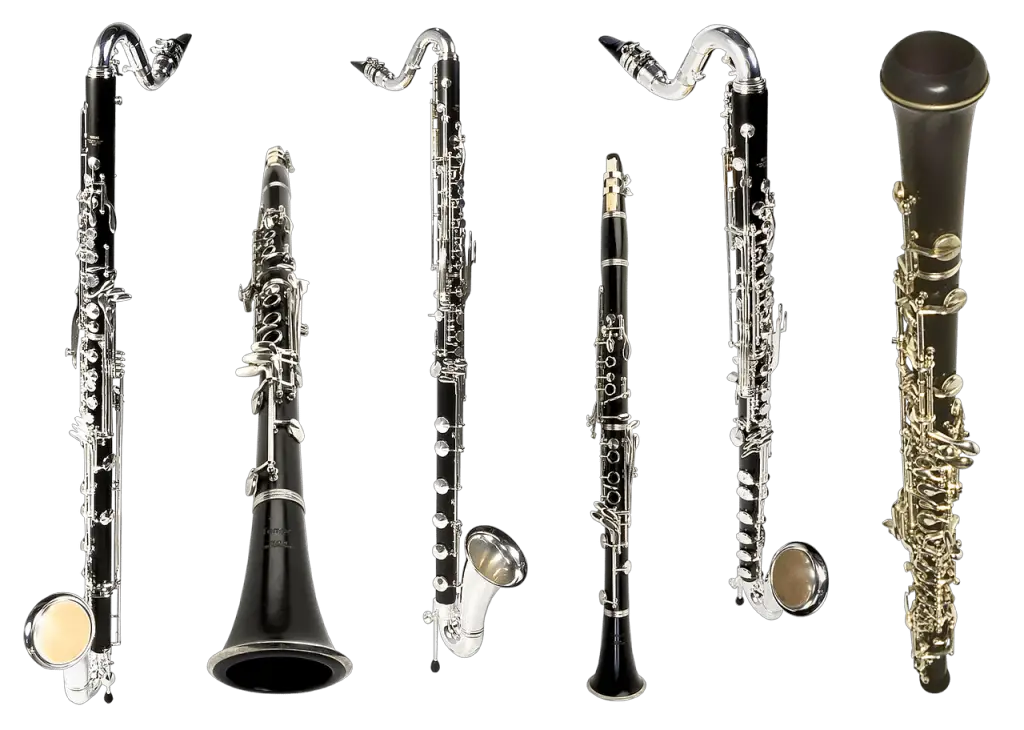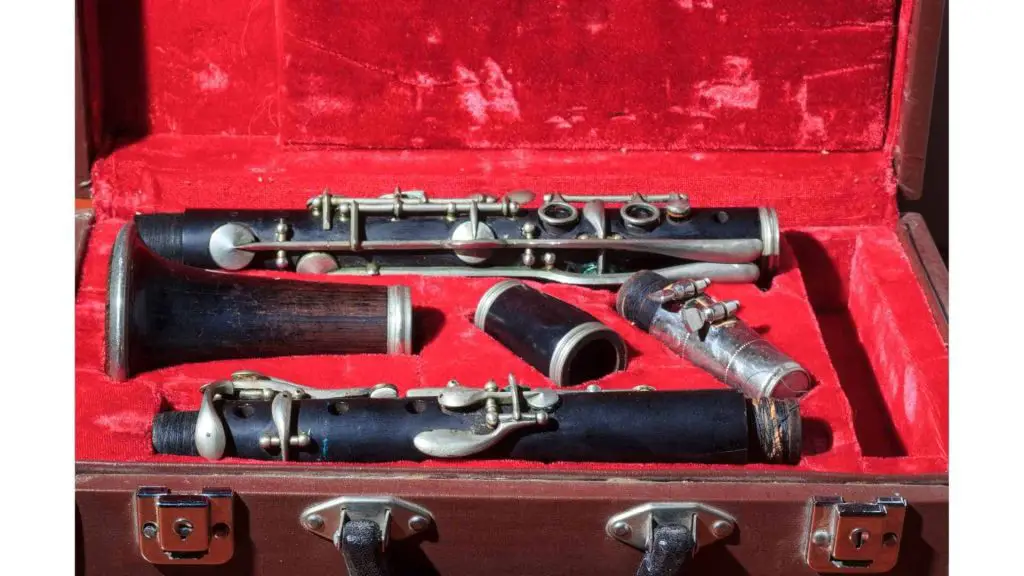Learning a new instrument like the clarinet or bass clarinet can be an incredibly rewarding experience!
If you enjoy the sound of the clarinet or bass clarinet, you may need to decide which instrument you would like to learn.
Clarinet vs Bass Clarinet: How Are They Different?
While the clarinet and bass clarinet are very similar in fingerings, they are two separate instruments, with bass clarinet being the much larger of the two. Many people learn the clarinet first because it is a less expensive instrument, but others choose to go for the richer, deeper sound of the bass clarinet right away.
This article will explain the similarities and differences between the clarinet and bass clarinet, including their difference in range, their construction, their fingerings, and the effort required to learn the instrument.
Table of Contents

Differences in Sound and Range
The biggest difference that you will notice between playing the clarinet and the bass clarinet is the difference in range, though both instruments are treble clef instruments.
The bass clarinet plays an octave below the clarinet, meaning that it has a greater versatility when it comes to playing parts in the bass range.
The clarinet is generally known as a soprano instrument, though its low range also has a beautiful depth of tone. It can play from concert D3 up to Bb6.
- – (The soprano clarinet is generally referred to as the Bb clarinet.)
Please forgive the 10 second pause early in this video about clarinet range, it still gives a good representation of what the full clarinet range sounds like:
The majority of the clarinet family plays in the key of Bb, including both clarinet and bass clarinet.
This means that the concert pitch note that sounds when the clarinet is played is two semitones above the note written on the page. (Concert pitch A is written in the key of Bb as B natural, etc.)
New clarinetists and bass clarinetists are often confused by this difference in written versus played range.
In terms of concert pitch, the modern bass clarinet in the key of concert Bb has a range of concert Bb1 to Bb5.
This video is a demonstration of what that sounds like on a bass clarinet:
Many bass clarinets meant for less experienced players only go down to concert F1 / written Eb below the treble clef staff.
Differences in Size and Construction
The bass clarinet is significantly larger and heavier than the clarinet. A clarinet fits in a case about the same size as a briefcase and is easily portable.
A bass clarinet fits in a longer, heavier case that may be more difficult to transport.
A standard bass clarinet is about 43 inches long. A Bb clarinet, on the other hand, is only 26 inches long.
The instruments are constructed very similarly, with a nearly identical set of tone holes and keys.
- This means that going back and forth between the instruments is easier since you only have to learn one basic set of fingerings.
The extended-range bass clarinet has more keys since it can go lower, so there is a brief learning curve required to master the lowest fingerings.
Ease of Assembly
- – Low Eb bass clarinets generally do not separate the top joint and the bottom joint.
- – Extended range bass clarinet: The mouthpiece, barrel, top joint, bottom joint, and bell are separated to be stored in the case.
- – Low C bass clarinets and Bb clarinets are generally stored in the same fashion with five pieces.

Ease of Learning Each Instrument
Learning the fingerings on the clarinet is not overly difficult, but it does come with some pitfalls along the way. One of the biggest problems that you might face is that the fingerings for each octave are different.
Unlike the flute and saxophone, the clarinet does not have an octave key but instead has a register key.
This means that when the key is pressed, the note rises by an octave and a fifth (C-D-E-F-G) instead of an octave. The bass clarinet has the same arrangement, with the register key in place of the octave key.
While the fingerings on the clarinet and bass clarinet are almost identical, you may find that it is harder to learn the bass clarinet because it requires more breath support.
If you are an adult beginner, you may find it just as easy to start on the bass clarinet as on the Bb clarinet.
Ability to Play While Self-Taught
It is certainly possible to play the clarinet or bass clarinet without formal lessons.
However, it is much easier to develop the correct posture and embouchure (how your lips, mouth, and face muscles are held while playing) if you have a few in-person pointers from a teacher or friend.
If you learn to hold your mouth and face muscles incorrectly, it is much harder to break this bad habit later on.
Tonguing to separate notes is another skill that you need to perform correctly from the beginning, or you will build bad habits that will make it hard for you to play advanced works.
Cost of Lessons
As far as lessons go, Bb clarinet and bass clarinet lessons cost the same.
Many clarinet teachers encourage their students to learn the Bb clarinet first and then transition to the bass clarinet, but they will work with you based on what you own.
Learning an instrument on your own involves a great deal of discipline, but if you have the will to work on it, you can become a successful clarinetist or bass clarinetist within a matter of months!
Startup Costs For Clarinet And Bass Clarinet
One of the primary differences between clarinet and bass clarinet is the startup cost.
You can get a decent beginner or intermediate Bb clarinet like the Yamaha YCL-255 for about $500 to $1,000. A professional wood model can cost up to $2,000.
Do not plan to pay less than $500 for an instrument if you want it to last!
A quality musical instrument should last for several years up to a lifetime, and if you buy a cheap clarinet, you will get what you pay for.
Look for customer reviews and ask friends who play what they have bought rather than going for the cheapest option.
In many cases, cheap instruments are not repairable and do not use standard parts.
Beginner Bass Clarinet Cost
A beginner or intermediate bass clarinet costs about $1,800, with professional models going as high as $12,000.
If you are just starting out, I recommend going for an intermediate-level plastic or resin instrument.
You can spend more on a wooden instrument when you have decided that you want the bass clarinet to be a lifelong pursuit.
If you have taken good care of your starter instrument, you should be able to recoup at least half of your money on the resale price.
As with the Bb clarinet, try not to look at new bass clarinets priced below $1,500 as you may not get a quality instrument for your money.
Focus on quality, durability, and repairability. Clarinets are delicate instruments that may need yearly adjustments.
- If you’re interested in learning bass clarinet, don’t miss my article on essential bass clarinet accessories that you’ll need to succeed!
Popularity
Due to the price difference, Bb clarinets are far more popular among beginners than the bass clarinet.
From a personal standpoint, I wanted to play the bass clarinet by the time I was in elementary school.
My elementary school and middle school band directors encouraged me to stay with the Bb clarinet until I was 13 and had reached the playing strength needed to keep up with the higher demands of the bass clarinet.
3 Helpful Tips on Choosing the Clarinet vs. the Bass Clarinet
Here are a few of my personal tips on choosing which clarinet to play:
Are you going to play in an ensemble or by yourself?
If you want to join a local community band, you will be in high demand if you are a good bass clarinetist.
Bb clarinetists are also in high demand, though slightly less so than bass clarinets.
If you want to play in an orchestra, there will be more opportunities for you if you stay with the Bb clarinet.
The bass clarinet was largely not involved in orchestra literature before the late 1800s, so popular composers like Mozart, Beethoven, and Bach do not have parts for them.
What kind of parts do you want to play?
In ensembles, bass clarinets may play lower notes which include many supporting parts. “Exciting” parts are often reserved for the upper clarinets.
However, there are many outstanding solos for the bass clarinet, including “Dance of the Sugar Plum Fairy” from the Nutcracker Suite.
If you play the Bb clarinet, you can expect to play melodic or moving parts more often.
Are you willing to commit the funds to a more expensive instrument?
The primary difference between the Bb clarinet and bass clarinet is the price. If you are willing to spend more, try the bass clarinet.
Deciding Between the Clarinet and Bass Clarinet
Both the clarinet and the bass clarinet can provide exciting and varied musical experiences.
I have played the clarinet and bass clarinet for over 30 years, and if I had it to do over again, I would not give up my experience!
However, if you are just starting out with a musical instrument, I would recommend buying a Bb clarinet as your starter instrument due to its price and versatility.